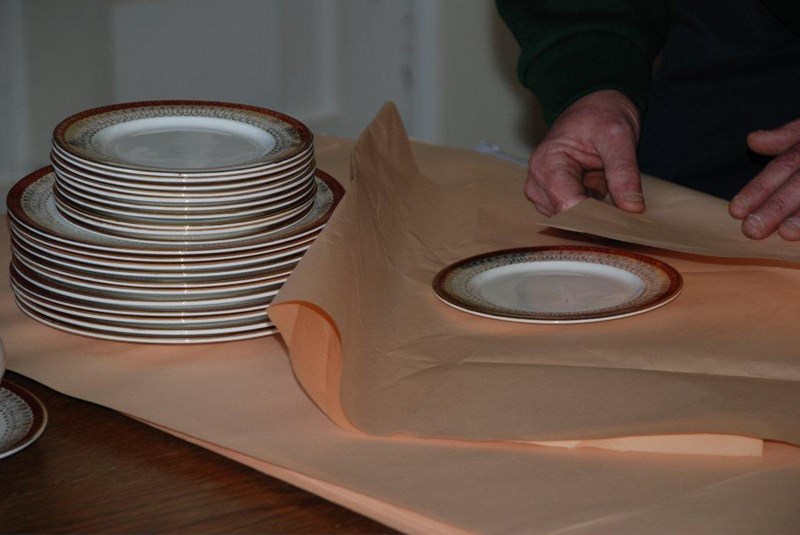How To Pack Flat China and Flat Glassware:
First, line the bottom of the dish pack with crumpled packing paper. With packing paper stacked neatly in place on the work table, center one plate on the paper. Grasp a corner of several sheets and pull the paper over the plate until the plate is completely covered.

Then, stack a second plate on the first. Moving clockwise, grasp another corner of several sheets and pull them over the second plate. Stack a third plate. Grasp the remaining two corners and fold using three sheets, one corner at a time over the plate. Turn the wrapped stack of plates upside down onto your paper. Re-wrap the entire bundle by starting with one corner of packing paper and pull two sheets over the bundle; cover the bundle with the second corner, then the third corner, and finally, the fourth. Seal the bundle with packing tape. When you place them in the dish pack, make sure the plates are standing on edge. Larger china and glass plates, platters and other flat pieces serve as a good bottom layer in the dish pack. Add two or three inches of wadded paper on top of the bundle to protect rims and make a level base for the next tier. Smaller plates, saucers and shallow bowls could make up a second layer. Wrap and pack these smaller items in the same fashion as larger items. Surround each bundle with crushed paper, being careful to leave no voids or unfilled spaces.

Position one cup 6 to 8 inches from one of the corners of your packing paper. Pull the nearest corner of the paper up and over the cup. Place a second cup directly on top with the handle to the left. The second cup should nest in the packing paper folded over the bottom cup. Pull the two side corners up and over one at a time and tuck the corners inside the top cup. Holding the two cups in position, roll the cups to the remaining corner. Place the cups in the dish pack in a vertical position, lips down, near the top of the box. Do not stack heavy items on top of the cups. Top off the layer with packing material.

Delicate cups, like china, should be wrapped individually first, protecting handles with an extra layer of clean paper then packed upside down.
Glasses and Stemware:
Before wrapping, stuff glassware and stemware with crumpled tissue or packing paper. Lay them on the corner of the paper and roll it one or two full rotations (one rotation for smaller items, two for larger ones). Pull the sides of the paper up and over the glass/stemware and continue rolling to the far corner. Delicate glasses and stemware should be placed toward the top of the dish pack in a vertical position.

Silver & Flatware:
To protect silver pieces from tarnishing, they should be completely enclosed in cloth or low-sulfur packing paper.
- Hollow ware – including bowls, tea sets and serving dishes—should be wrapped carefully like fragile items and packed like china.
- Loose flatware may be wrapped individually or in sets, and in paper, clear plastic or small gift boxes that are then secured with tape.
- Even if silverware is in a chest, consider wrapping the pieces individually and re-position them in the chest. Or, fill all voids in the chest with newsprint to prevent shifting. Wrap the chest in an old blanket or a moving blanket (which we can provide you with) to prevent scratching.























Comments